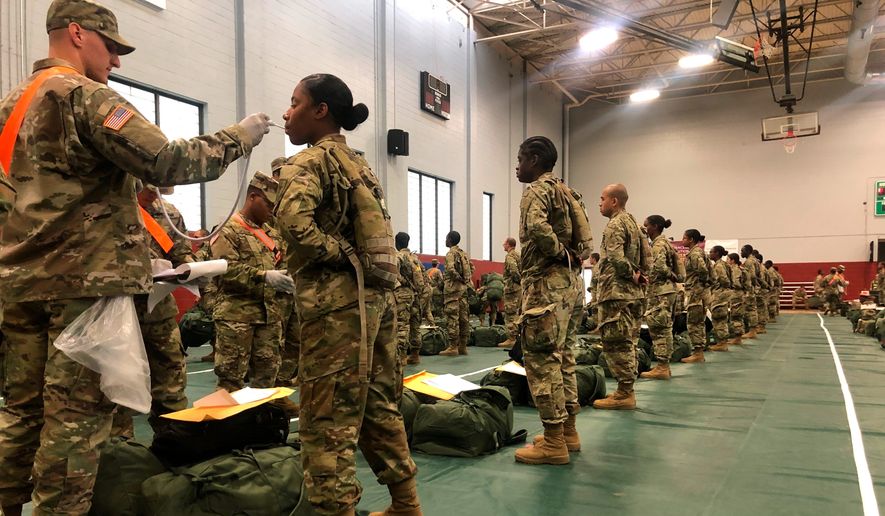With new marching orders, the Army is turning to technology to give its soldiers in combat a crucial edge where every second can mean the difference between life and death.
For 20 years, the U.S. military focused its attention on battling terror groups like al Qaeda and Islamic State in places like Iraq and Afghanistan. Tanks and artillery were mostly sidelined as relics of the Cold War.
But, the need to counter aggressive “near-peer” adversaries like Russia and China, as outlined in a major new strategic blueprint issued in 2018, has led the Pentagon to add new chapters to their old playbook.
The Army picked the unforgiving landscape of Yuma, Arizona’s barren desert to test its new ideas in a five-week operation called Project Convergence 2020. Senior Army leaders last week recounted the first fruits of the mission in a briefing at Fort Myer near the Pentagon.
Project Convergence reflects the need to rapidly merge a variety of assets — both in the air and on the ground — into a single combat element, the focus of the new training regime.
“We knew that if we could accomplish our mission [in Yuma], we could do it almost anywhere on earth,” said Brig. Gen. Ross Coffman, who led the exercise. “We wanted to put them through their paces in an environment that would be brutal.”
In the exercise, an unidentified country had invaded its neighbor. On a giant map of Yuma projected on the floor of a cavernous hall at Fort Myer, a boundary line showed the disposition of friendly and enemy forces.
“They put air defense assets in place. They put in long-range fires and they put in command-and-control nodes,” said Brig. Gen. Coffman.
The Army used a variety of ground, air and even space sensors to detect the enemy targets. The “brain” of the exercise was a cutting-edge artificial intelligence system called “Firestorm.” Within seconds, it processes a flood of data — from target information and terrain analysis to local weather conditions — before recommending a plan of attack.
“This may not only be the most important thing Army Futures Command works on, this may be the most important thing the Army is doing,” Gen. John M. Murray, commander of the Army Futures Command, agreed.
Firestorm at one point in the exercise dispatched troops to take out a pair of Russian-built air defense systems with an artillery barrage which itself reflected the Army’s evolving capabilities.
“We used our new rocket-assisted projectile. It has a range of over 40 kilometers and landed with single-digit meter accuracy,” said Brig Gen. John Rafferty, director of the Long Range Precision Fires cross functional team at Fort Sill, Oklahoma.
By 2023, the Army plans to field its first battalion using the extended range cannon artillery system — made up of the cannon itself, a supercharged propellant and a new projectile that can correct its course through GPS.
The Army is also developing long-range precision fires in order to overcome what in Pentagon jargon is called the enemy’s “anti-access, area denial” (A2AD) capabilities, along with any air and missile defense systems that could help defend an adversary’s air force.
Pentagon officials said they also have the ability to swarm a target area with small, cheap drones. In Yuma, the Army learned that remaining low to the ground during an attack was crucial.
“There’s a lot of radar clutter and some of their sophisticated systems that we were hunting had a hard time seeing us,” said Brig. Gen. Wally Rugen, with the Army’s Future Vertical Lift team based at Redstone Arsenal in Alabama. “We can hit them but they can’t hit us. We don’t like a fair fight and we proved that.”
During the Yuma exercises, the Army also tested robots that could conduct reconnaissance and mapping missions on their own then pass the information back to their human operators for any final decision.
“It’ll allow commanders to have additional decision space and be in a position of relative advantage over the enemy,” Brig. Gen. Coffman said.
Firestorm was developed by the federal government. Because it isn’t owned by a private company, the Army wasn’t required to seek permission before adjusting it at the scene.
“We were able to use coders on the edge of the battlefield to change it in real time. It is a huge benefit, both monetarily and at the speed of combat,” said Brig. Gen. Coffman.
The sheer speed and density of information transmission on the battlefield, the ability to pass targets from sensors to shooters in seconds, will fundamentally change how battalions and brigades fight future wars, he predicted.
“What we saw in Project Convergence 2020 is transformational in speed of action,” Brig. Gen. Coffman said. “The technology is here today.”
• Mike Glenn can be reached at mglenn@washingtontimes.com.




Please read our comment policy before commenting.